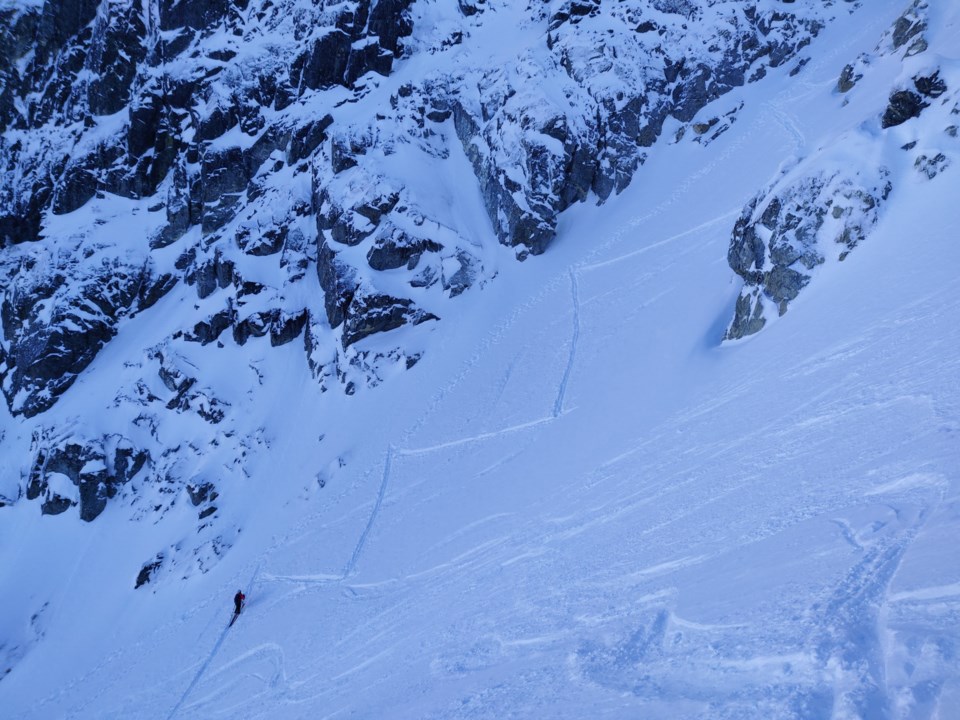I’ll be first to admit that over the years I’ve put myself in some pretty precarious positions in the mountains. It all starts in the very extensive terrain of our own Whistler Blackcomb; poking around looking for pow stashes and getting cliffed out, thinking you’re on top of the right line in terrible visibility and finding out the hard way you’re actually not, misjudging the snow conditions and having to ski scary exposure with your edges sounding a death rattle.
Most of us escape these questionable decisions without painful consequences. Unfortunately, some of us do not.
Every first or second-year Whistler skier has a story of getting stuck somewhere, surrounded by cliffs and having nowhere to go (or going on a sojourn down Cake Hole and hopefully turning up a day later). Second-year skiers have a greater tendency, because they have just enough knowledge of the mountain, to get themselves into trouble, but not the wisdom to avoid the risk in the first place.
Some don’t learn their lesson after the first two years and develop a reputation for being that “loose” guy who’s always pushing their friends into questionable situations.
The Sea to Sky backcountry is a whole other kettle of fish. For better or worse, equipment and skill barriers to ski touring have all but evaporated. Some people are ski touring before they can actually ski at an intermediate level. A Pemberton Search and Rescue worker once described to me some of the skiers he’d come across in the Duffey Lake Road zones as “having no business being there.” That sounds judgmental, but coming from the folks who have to pick up the pieces of a ski-touring day gone wrong, I understand where he was coming from.
No one gets to dictate who gets to go out into the backcountry, of course. But getting better at skiing—to a point where you can confidently handle scary situations—is hard when you’re only getting two or three laps a day in the backcountry. The resorts are crowded, yes. But they produce better skiers much quicker, especially if you invest in lessons or devote a season to getting 30-plus days of downhill skiing in every condition imaginable.
Managing risk in the backcountry is a different equation for everyone to solve. The reward of skiing that sick line needs to be balanced against both the probability of the slope sliding and your own ability to ski it (as well as managing the outcome, if it does slide).
This applies to uptracks as well; just because you’re strong enough to put in a skin track straight up a face doesn’t mean you should. I witnessed this when I was early-season touring in the Blackcomb backcountry one year. My friend and I slid around the corner to drop into Husume and saw a skier floundering up steep switchbacks her friends had cut in straight up the ski line. The rest of the party was at the top of Husume transitioning, no one watching their friend who was struggling up such a steep slope with another party of skiers waiting above her to drop in.
This was an obvious shortcut decision, likely with an Alpha group leader assuring his followers that he could break trail and save his party significant time bypassing the long way around up the Blackcomb Glacier and over the East Col. This is a shining example of the heuristic trap known as the Expert Halo, where less-experienced members of the party tend to agree with the person in the party who has (or is perceived to have) the most experience.
Another time I witnessed a questionable decision near the top of the Northwest Couloir on Wedge Mountain. We had just topped out on the climb up the couloir and another team of three was getting ready to drop in. The leader was a skier who had two less-experienced snowboarders in tow. He dropped in, skied down quite fast and waited right in the middle of the couloir for his friends. The next snowboarder dropped in aggressively, lost an edge after hitting the mixed spring snow conditions in the couloir, and proceeded to slide down about 50 to 60 metres on his ass before regaining control.
“Dude, you scared me!” yelled the skier leader, half laughing. “What’s wrong with you?!”
“I dunno, lots of things!” replied the clueless snowboarder, oblivious to how much he had risked the livelihood of his friend (and himself) with an out-of-control collision.
The second snowboarder dropped in and did the exact same thing (ass slide and all), treating the couloir as if it was right next to the Peak Chair. The whole crew laughed about the experience and more or less party shredded down the rest of the couloir.
Was this team of cowboys an example of blatant disregard for their own safety and that of their friends? Or was it because they just had no idea, and their friend talked them into skiing the Wedge NW Couloir as something cool to do on a Saturday in April?
Many of us choose not to say anything to other people in the field for fear of sounding elitist. We just shake our heads, carry on and keep an eye out for a potential incident. Judgment flows more easily if it ends up as a post on the South Coast Touring Facebook group, but such rants rarely make it back to the (ir)responsible parties, and would likely have little effect on their backcountry decision-making anyway.
The best thing we can all do—if we consider ourselves responsible backcountry citizens—is to lead by example. The more people see cowboy behaviour in the backcountry, the more they will emulate it. And with thousands of people now ski touring every weekend, good examples of risk management and sound decision making are more important than ever.
Vince Shuley has learned from mistakes made earlier in his backcountry career. For questions, comments or suggestions for The Outsider email [email protected] or Instagram @whis_vince.






